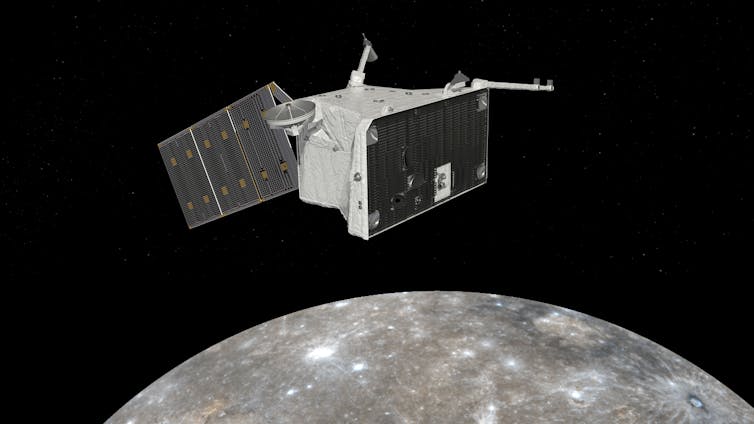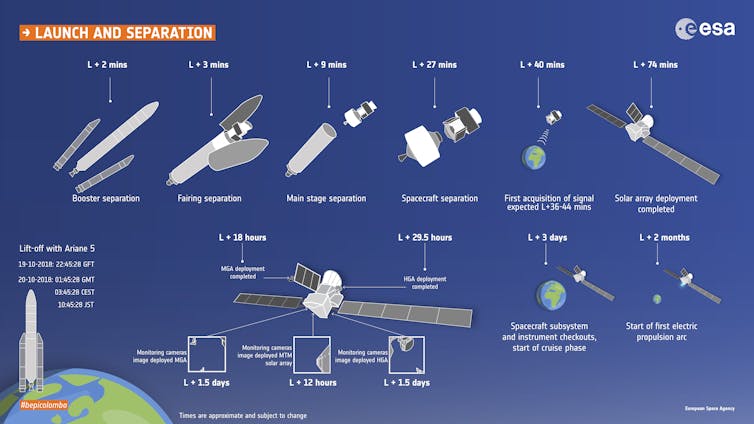
The mission comes 25 years after a group of scientists first proposed to ESA that it should send a probe to Mercury, and 18 years after ESA approved the project as a “cornerstone” mission. This is the category of world class, scientifically excellent missions needing significant new technology development. Previous ESA cornerstone missions include the Rosetta comet mission and the LISA Pathfinder gravitational wave observatory.
But why Mercury? It is a puzzling planet. NASA’s MESSENGER orbiter (2011-2015) revealed many reasons why scientists are keen to learn more about it. These include the planet’s abnormally large core – we don’t know why it is still molten and able to generate a magnetic field, unlike that of Mars or Venus. Another mystery is the abundance of (largely unidentified) volatile substances at its surface. These ought not to have been incorporated in a planet that formed so close to the sun as Mercury now is.
BepiColombo’s initial course after three days of orbiting the Earth for checkouts will be an elliptical orbit about the sun. This will begin by taking it inside the Earth’s orbit. But early in 2019, it will cross outside it for most of the year. It will then move back inside before coming very close to the Earth in April 2020.
Each flyby, shown in the animation above, has to be executed perfectly. Things could go wrong, especially during the launch, but I have ample confidence in the abilities of ESA’s flight control team at Darmstadt, Germany.
The mission, which is named in memory of Giuseppe (Bepi) Colombo who first proposed gravity-assist flybys for spacecraft, is a joint venture between ESA and its Japanese counterpart, JAXA.
The stacked spacecraft carries two orbiters. ESA’s is a two-metre long unit, massing more than a tonne, referred to as the Mercury Planetary Orbiter, MPO. I suspect that after it begins to orbit Mercury, it will inherit the name of BepiColombo or maybe just Bepi. The Japanese orbiter is smaller, and its mass is about a quarter of ESA’s orbiter. Originally called the Mercury Magnetospheric Orbiter, MMO, in June it was awarded the name Mio, which in Japanese carries connotations of safe navigation. During the cruise to Mercury, Mio will be housed inside a sunshield and attached to one side of the European orbiter.

The sun’s enormous gravity means that more energy is needed to get into a stable orbit about Mercury than would be needed to send the same spacecraft to vastly more distant Pluto. Because of this, the ion drive will be operated at intervals amounting to about half the cruise duration, mostly to slow the spacecraft down.
Unfortunately, the stacked configuration of the combined spacecraft impedes its ability to do science during the planetary flybys. Some scientific data will be collected, but the best pictures we are likely to get during flybys will be from the selfie-cams mounted on the MTM.
On arrival at Mercury in late December 2025, the transfer module will be detached. Mio, spinning at 15 revolutions per minute for stability, will then be liberated into a strongly elliptical orbit about Mercury. As soon as this happens, JAXA will take over Mio operations and guide it through its tasks studying the planet’s magnetic field and the associated space environment.
ESA’s orbiter will then jettison the sunshield, its last impediment, and use its own chemical thrusters to achieve a closer, more circular, orbit about Mercury. From there it will study the planet’s surface by using an assortment of cameras and other instruments. This should pin down the composition and geological history in much better detail than the smaller and less complex MESSENGER. The orbiter will also carry a magnetometer so that both it and Mio will be able to report magnetic conditions at two places simultaneously – an important first for a deep space mission that should teach us about the speed at which disturbances travel through the planet’s magnetic field.
It’s exciting to think that BebiColombo may transform our knowledge of Mercury in just a few years. And while you wait, from October 23, you will be able to listen to some beautiful, evocative music that the planet has inspired as part of the Planets 2018 project. This was set up to commemorate the centenary of Gustav Holst’s Planets Suite with music inspired by the science of the planets.
About Today's Contributor:
David Rothery, Professor of Planetary Geosciences, The Open University
- David Rothery is co-leader of the European Space Agency's Mercury Surface and Composition Working Group, and a Co-Investigator on MIXS (Mercury Imaging X-ray Spectrometer).
- He has received funding from the UK Space Agency and the Science & Technology Facilities Council for work related to Mercury and the European Space Agency's Mercury orbiter BepiColombo, and is currently funded by the European Commission under its Horizon 2020 programme for work on planetary geological mapping (776276 Planmap).
- He is author of Planet Mercury - from Pale Pink Dot to Dynamic World (Springer, 2015), Moons: A Very Short Introduction (Oxford University Press, 2015) and Planets: A Very Short Introduction (Oxford University Press, 2010).
- He is Educator on the Open University's free learning Badged Open Course (BOC) on Moons and its equivalent Future Learn Moons MOOC, and chair of the Open University's level 2 course on Planetary Science and the Search for Life.
This article is republished from The Conversation under a Creative Commons license.
Bonus Video:


















